All about Tatar honeysuckle

Tatar honeysuckle is a very popular type of shrub, which is actively used in the landscape design of gardens, parks, personal plots. Due to its good immunity and unpretentious care, this plant has won the hearts of gardeners of different levels.
Most often, this variety is used to form hedges, but it can also be safely used in the garden as a decorative decoration of the site. Cultivation and care have their own characteristics, although they are not very difficult.


general description
Tatar honeysuckle was used to decorate gardens and parks in the 18th century. She began her march in Europe, then spread to different regions, including Russia. In our country, it grows not only in the European part, but also in the Siberian and Altai regions. This shrub tolerates different climatic features well, is unpretentious and very decorative. That is why this variety is actively used in landscape design in different countries. There are a lot of types of honeysuckle, but only a few of them are edible, most of them are not eaten.
The Tatar variety is inedible, and even more toxic. Its berries contain poison - hydrocyanic acid. Nevertheless, the berries are harvested, but used exclusively for medicinal purposes.


The botanical description of the shrub includes the following points.
- Bush. It belongs to a number of tree-type shrubs, in nature it grows about 4 m, in the landscape it is much lower. The diameter of the crown varies from 2 to 5 meters, but in gardens and parks the shrub is more neat and miniature. The height reaches a maximum of 3 m, the width is up to 1.5 m.
- Sheet. The foliage is small, the color is green, dark, the shape is elongated like an egg. Length can vary from 3 to 6 cm, petioles are short. Leaves don't need a lot of sun.
- Bloom. The flowers are also not particularly large, in shape they resemble a two-lipped bell type. As for the color, it all depends on the variety. There are very light - cream, white, pink and dark - purple, red. In length, the flower grows more than one and a half cm. The aroma is pronounced, the flowering is not particularly long, appears 3 years after planting.
- Fetus. The berries are spherical in appearance, small. The color can be juicy red or yellow, orange. Fruits ripen in mid-summer and until September.
- The escape. Inside, they are empty, the bark is light brown with a yellow tint or gray in adulthood, tends to exfoliate.



In nature, this type of honeysuckle grows actively, the bush stretches for several kilometers and turns into thickets. Bushes grow on forest edges, in valleys, on hills, and adapt well to shady conditions. In the fall, when the foliage falls off, honeysuckle does not look very aesthetically pleasing. But the rest of the time, when the plant blooms and is decorated with ripe fruits, juicy foliage, decorativeness is high.
Despite the fact that berries are not eaten, they are important from the point of view of aesthetics. For the fruits to set, honeysuckle is planted more than one variety, two or three are needed for cross-pollination.
The flowers of this plant attract insects; they are excellent honey plants.


The best varieties
There are quite a few varieties of Tatar honeysuckle - 12, all of them differ in color of flowers, shade and shape of fruits, type of crown.All representatives of honeysuckle tolerate drought well, are distinguished by good immunity. Usually in the landscape, different combinations of varieties are used to achieve an exquisite composition.
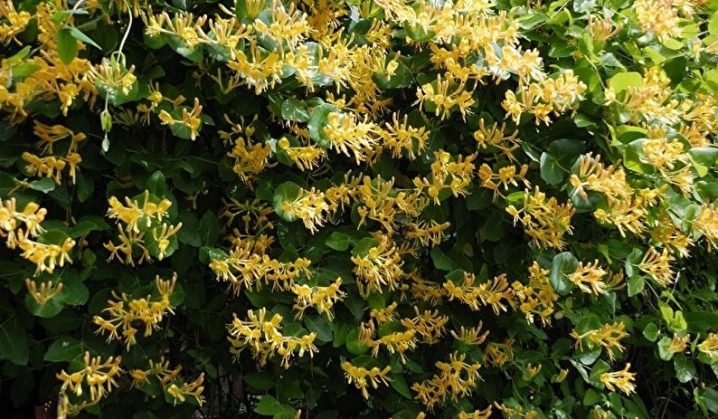
Rosea:
- refers to tall, height reaches 4 m;
- the crown is in the shape of a pyramid, grows densely and quickly;
- crown diameter - about 2 m;
- flowering - large, the size of the flowers can reach 2 cm, the shape of a bell;
- the color is pinkish, light, but gradually the color changes to juicy pink;
- blooms for about 20 days or more;
- fruits have an orange tone.

Hux Red:
- differs in a crown of a spreading type, the stems are crimson;
- flowering is very abundant and intense, the layer of flowers is very dense, covers the bushes almost completely;
- flowering time - late spring and early summer;
- fruit color - dark purple, inflorescences consist of large buds, the shape resembles a tube;
- the plant looks impressive even after the flowers have fallen, the fruits are very beautiful, have a rich red tint;
- excellent frost resistance of the variety makes it very attractive for regions with harsh climates.

"Grandiflora":
- the flowers of this plant are large and very showy, white, reminiscent of the "Alba" variety;
- the shrub is not capricious, gets along well with any plants;
- used for planting in a row, hedges;
- calmly tolerates negative environmental conditions, therefore it is often used in the urban landscape.

Casanova:
- very popular tall shrub - about 4 m;
- characterized by intense flowering, stunning aroma;
- color - non-standard, there are snow-white and reddish flowers;
- strong immunity allows the plant to develop very actively.
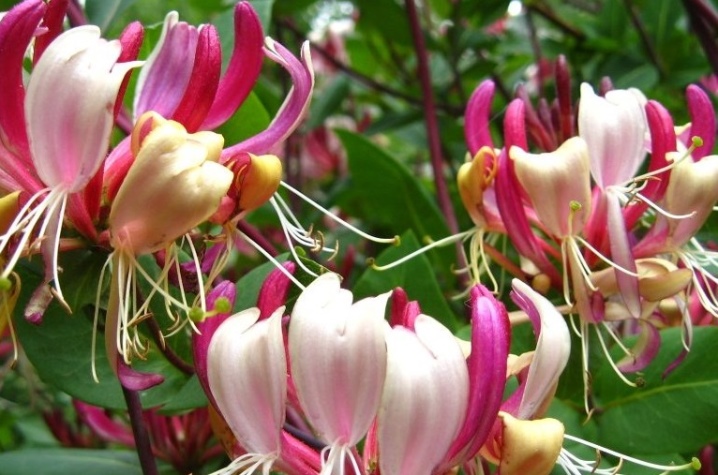
Elegance:
- the variety is considered highly decorative, thanks to its spectacular colors - bright red with lines of pink tones;
- foliage - small;
- in general, the shrub looks luxurious, very refined, elegant, which is why it got this name.

"Zabelli":
- another variety, which has a high aesthetic value, is often used in various landscape ensembles;
- flowers have a burgundy-crimson tone;
- berries are red, light in color, hang on the bushes for a long time, until the first snowfalls;
- the size of the shrub is medium, but the type is spreading;
- the variety perfectly tolerates unfavorable weather conditions, it can do with almost minimal maintenance.

Arnold Ed:
- fruits grow in pairs - this is how the variety stands out from others;
- foliage is oval, color - green;
- berries - red, rich shade;
- grows successfully in an urban environment, calmly tolerates gas pollution.

Morrow:
- the crown of the bush is dense, dense;
- the bush is compact, grows to a height of about one and a half meters;
- leaves with sharp tips, green;
- flowering begins in May, the shade is white, the petals are very thin;
- fruits are collected in pairs, but do not grow together, the color is dark purple, but sometimes orange.
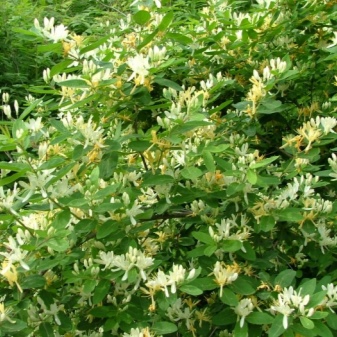

Selection of seedlings
Before planting Tatar honeysuckle, you need to decide on the goal. There are several tasks that this plant can solve:
- create a live-type hedge;
- decorate the gazebo, facade, terrace;
- supplement the site with a single presence;
- participate in a multilevel ensemble.
The honeysuckle variety is chosen based on the tasks set by the designer or gardener. It is important to take into account the color of fruits, flowers, to choose a harmonious neighborhood, although the fruits will not appear in the first year, this moment is important.
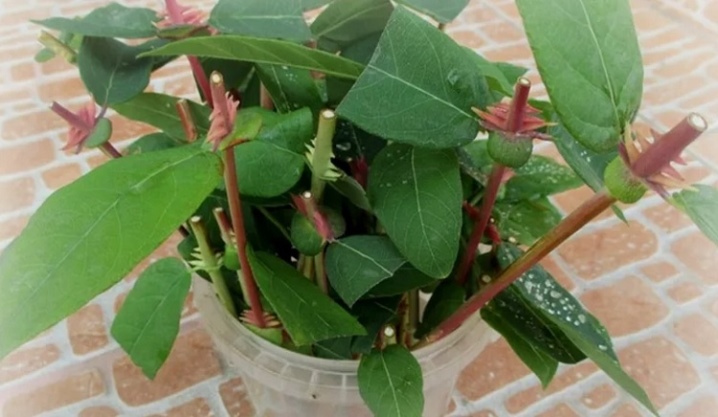
The second moment on which the successful solution of the problem depends is the choice of a seedling. More than half of your success depends on it, so avoid hand-held purchases. It is better to give preference to proven specialized markets.
Pay attention to the following characteristics:
- optimal age - from 2 to 3 years;
- the obligatory presence of 3 or 4 shoots, the length of which should not be less than 30 cm and more than 40 cm;
- the type of plant is absolutely healthy, the root system is developed, the branches are elastic, the buds are greenish, the bark is smooth, without damage.
You should purchase at least two varieties of plants, and preferably 3 or 4, in order for high-quality pollination to occur.


Landing
In order for the shrub to take root well and develop actively, it is necessary to follow the planting rules.
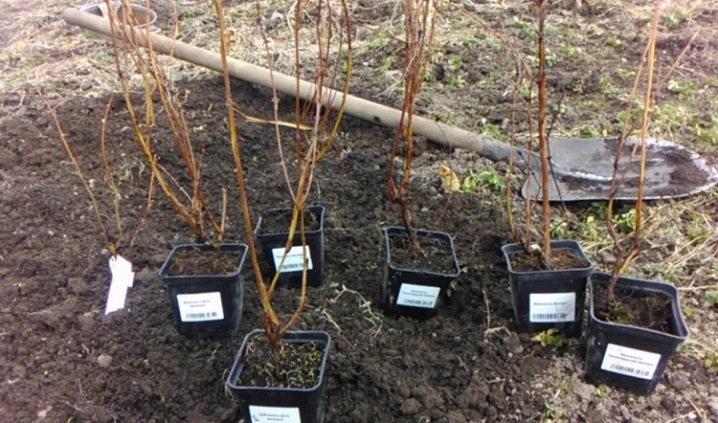
Timing
The optimal time for planting is the autumn period, especially the last decade of September. At this time, the seedlings take root well. Choose a not hot day, but not too cold - from +10 to +20 C. If the root system is closed, the bushes can be planted in a permanent place at any time of the season.

Seat selection
This variety takes root well on different soils, in almost any climatic conditions. Honeysuckle grows well in the shade, in city smoke and gas, in dry areas. Frost over 30 C is not a hindrance to her either. But in order for the shrub to grow aesthetic, healthy, not to lose its decorative properties, it is necessary to provide comfortable conditions, at least conditionally favorable. Therefore, when choosing a site, you need to evaluate the soil, the ratio of the variety to light, and other nuances.
Adequate lighting has a positive effect on the development of the bush, while partial darkening is not a hindrance. If the honeysuckle grows in the shade, the flowers and berries will be small. The soil is chosen at least approximately fertile, with a sufficient amount of moisture, and loose. The acidity level should be normal, salinity is acceptable, drainage is important. Heavy soil, swampy areas are not suitable. Groundwater should not be closer than 1 m to the surface.

Technology
The seedling well is prepared approximately 4 days before the procedure. Consider the size of the clod of earth, the hole is dug out one and a half times more. The width and depth of the dug are the same, about 40 cm. A minimum distance must be observed between the plants - about 2 m (if the variety is low), about 3 (if tall).
The landing algorithm is as follows:
- a drainage layer forms at the bottom, fragments of bricks, expanded clay are suitable, a layer of at least 10 cm;
- then nutritious soil is poured, into three parts of chernozem - part of organic matter, part of sand, kilo ash and 50 g of phosphate additive;
- the deepening in this form should stand for a day or two;
- then a solution of potassium permanganate is poured in for disinfecting purposes;
- a lump with roots is first placed on polyethylene, the presence of putrefactive or damaged areas is checked;
- after that you can place the seedling in the pit;
- from above, the roots are covered with fertile soil;
- the near-trunk circle is covered with ash, you can spray it with a manganese solution;
- after the trunk circle is mulched with sawdust, peat, you can use needles, humus.
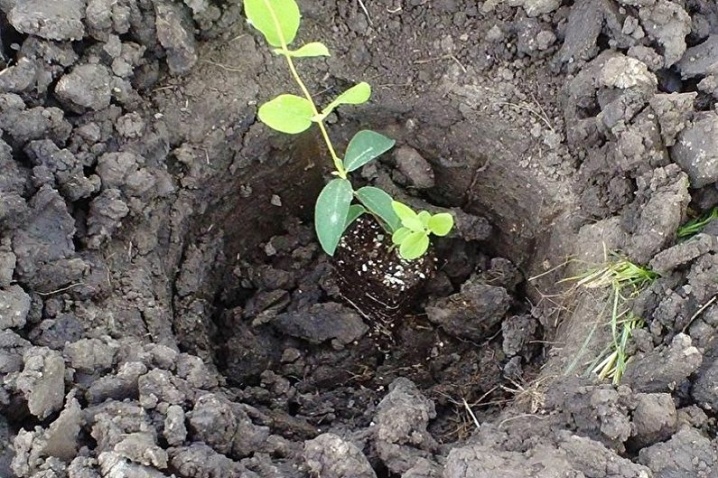
Care
Caring for this representative of the flora is not too difficult, but there are a number of mandatory procedures.
Watering
Mature plants do not need moisture, unless the weather is too dry. But young plants are moistened regularly, daily for the first 30 days. Then the plant only needs watering once a week. As soon as the shrub reaches two years of age, it is enough to shed it twice a season, a maximum of three times. A ten-liter bucket of water is enough for an adult plant.
After each procedure, you need to mulch the soil.


Top dressing
If the soil is moist and fertile, it is not worth fertilizing the shrub additionally for a long time. Once disembarked, you can ignore this phase of leaving for two or three years. A mature plant should be fed in the spring with nitrogen compounds and complex ones - before flowering. In the autumn period, it is enough to sprinkle the soil with ash and dig it up.


Pruning
Honeysuckle of this variety must be pruned, there are different types of this procedure. In the spring, the bushes are formed before the formation of buds, at which time a sanitary-type pruning is carried out. They remove the branches growing near the ground, dried up, sick. This type of pruning is done every year on plants over 6 years old.
Autumn pruning is done after the leaves have fallen, but this is not the best time to form a bush. During this period, there is a risk of cutting off the buds that will bloom next season. Thus, you can lose a significant number of inflorescences. In addition, there is an increased risk that the plant will suffer frost damage. Shrub trimming can be carried out throughout the season, honeysuckle tolerates these procedures well. But it does not need to be done every year, but with interruptions of a year or two.
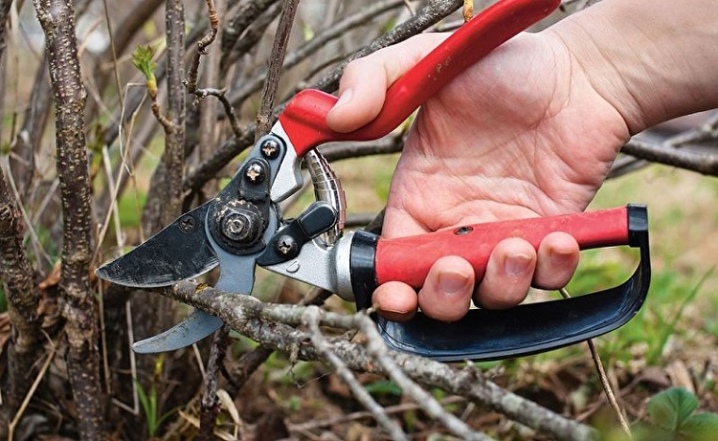
Preparing for winter
Both wild and cultivated shrubs of this variety are distinguished by excellent winter hardiness. They tolerate even very low temperatures well, as for foliage and flowers, they do not die if the temperature is above -8 C. Therefore, mature plants are not insulated for the winter, but this procedure is very useful for young ones. In the first couple of years, the seedlings are covered with spruce branches, then it is enough to mulch the soil of the trunk circle.

Reproduction
This type of shrub reproduces easily in different ways. Experienced gardeners prefer growing from seeds, they also actively propagate by cuttings and dividing the bush.
Cuttings:
- in the summer, you can cut off shoots that are a year old, in autumn those that are stiff;
- fall cuttings are added for the winter;
- shoots of the current season are cut into pieces of 10 cm, determined in a container with peat and sand;
- before planting, the shoots are treated with stimulating solutions;
- then they are placed in a container with a substrate at a slight angle, covered with a film;
- after the appearance of the first leaves, you need to cover the containers with spruce branches and leave to winter;
- in the spring, the seedlings are determined for a permanent place in the open ground.


Reproduction by layering:
- use layering of adult bushes - 3 or 4 years;
- the branch should be large, without signs of ill health, it is tilted to the soil and fixed, sprinkled with earth on top;
- after the appearance of vertical shoots, it can be concluded that rooting is successful;
- the seedling is separated from the mother branch in the spring and is permanently located.
Layers take root almost always, this method is the most successful.
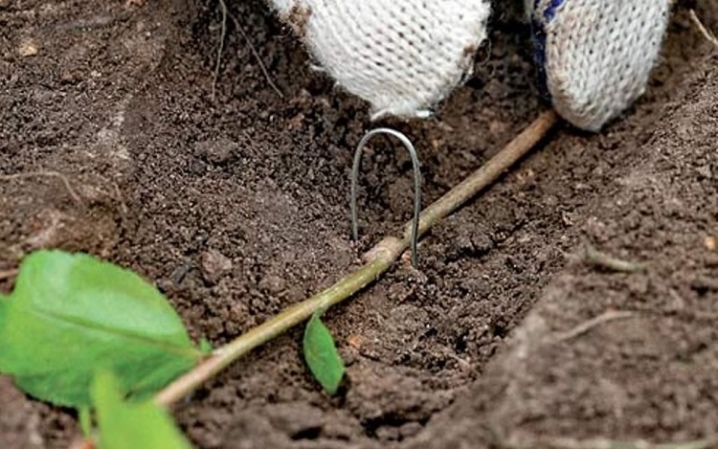
Seed method:
- since this method is laborious, it is used only in exceptional cases by professional gardeners;
- a wild plant can eventually bring its seeds, so it is better to buy the material;
- seeds are sown so that by winter they not only germinate, but also form a mini-crown of several leaves;
- for the period of winter, the plant is carefully covered, released in the spring;
- sowing is best done in March or April in the substrate;
- autumn sowing germinates in spring.


Diseases and pests
Long damp weather is not suitable for Tatar honeysuckle - this provokes the development of a fungus, for example, powdery mildew. In addition, various insects can harm it.
- Powdery mildew. If a white bloom appears on the branches and foliage, dark spots are symptoms of dew. If the further development of the disease is not prevented, the shrub will begin to weaken, dry, freeze in winter. It is important to remove all damaged areas and burn them. Then spray with any drugs for this disease, for example, Bordeaux liquid or "Fitosporin".
- Cercosporosis. Another fungal attack, which is characterized by spotting on the leaves. They change color from green to gray and burgundy. It is necessary to destroy all infected foliage and spray with Bordeaux liquid, soap, copper sulfate.
- Aphid. This pest provokes drying of the plant, curling of leaves and tops. It is important to spray the plant with “Aktellik” before the buds develop, and during the season to process it with “Aktara”.


Use in landscape design
The honeysuckle of this variety is used for decorative purposes. Due to the fact that the bushes are tall and dense, they make an excellent hedge. Pruning depends on what goals you are pursuing:
- for a high hedge, the bushes are not pruned;
- for the average cut to the level of one meter;
- for low - about 70 cm.
Also, the bushes look great in a single installation, they can be tied to trellises, creating different compositions. For such ensembles, it is better to use varieties that have elastic type branches. Honeysuckle, which is not very tall, ideally complements the alpine slides. Also, using this plant, they decorate facades, pediments, terraces and gazebos, arches.
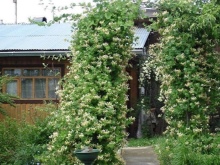

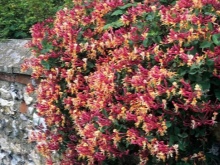










The comment was sent successfully.